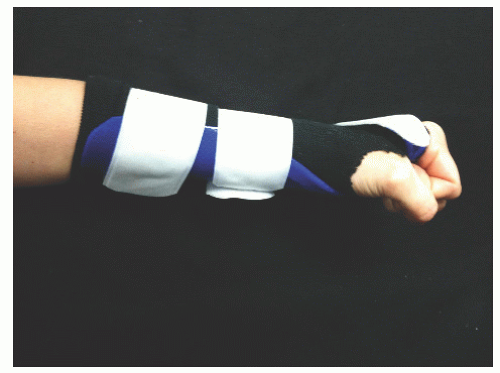Elbow Rehabilitation
Laura Walsh
Gayle K. Severance
LATERAL EPICONDYLITIS
A referral to therapy is important to the rehabilitation process of lateral epicondylitis. A recent study demonstrated significant decreased pain and improved function in subjects who participated in a supervised therapy program for treatment of lateral epicondylitis when compared to subjects who were given a home program with no therapy supervision.1
Conservative rehabilitation of lateral epicondylitis consists of two phases: an acute phase and a restorative phase.
Acute Phase: The primary goal during the acute phase of rehabilitation is to decrease pain. A wrist extension orthosis (splint) or a counterforce brace is often used to allow rest of the irritated area. The wrist orthosis holds the wrist in slight extension, placing the wrist extensors in a resting position, reducing tension on the forearm extensor tendon origin2 (Fig. 71-1). This orthosis can be custom made by the treating therapist during the first therapy visit. Fabrication of the wrist orthosis by the therapist is ideal to ensure proper positioning and fit. Although a wrist brace can be purchased over the counter, it is not customized to the patient, resulting in an incorrect position or fit. The counterforce brace is a prefabricated nonelastic strap that can be purchased over the counter. Proper fit is typically not a problem with the counterforce brace, although proper positioning is important. It is worn over the extensor muscle belly limiting full expansion of the extensor muscle mass during use, thereby decreasing force transmission to the inflamed tendon origin.3 Patients often place the strap over the elbow at the area of pain, rather than over the muscle belly. The therapist can instruct the patient on proper positioning (Fig. 71-2). Pain reduction has been demonstrated with either option, although greater pain relief has been reported with use of the wrist extension orthosis.4 We encourage our patients to wear the wrist extension orthosis during activity as much as possible. The counterforce brace is a good alternative when demands of daily living make it unrealistic to wear the wrist orthosis, being less restrictive and yet proven to decrease pain with gripping activity.5
Activity modification education is important to promote rest. In general any activities that increase symptoms should be avoided, but patients benefit from more specific instructions to rest the forearm musculature. Education to avoid resistive, repetitive wrist and grip activity is imperative to recovery. We often give our patients specific examples such as limiting yard work and house cleaning tasks. Patients are also instructed to avoid lifting or pulling heavy items. When avoidance of lifting is not an option, the patient is instructed to pull into a wrist-flexed position to engage use of the wrist flexors rather than the extensors (Fig. 71-3). Typical examples are lifting a bag or opening the refrigerator by pulling into wrist flexion rather than wrist extension. All lifting should be done while holding the arms close to the body with elbows bent at 90 degrees promoting overall good body mechanics.
The forearm extensor musculature becomes tense and tight due to pain and disuse. Patients are instructed to perform a “forearm extensor wad stretch.” This stretch consists of painfree progressive wrist flexion, elbow extension, and forearm pronation. Overpressure can be applied with the other hand as tolerated to attain a greater stretch (Figs. 71-4 and 71-5). Stretches should be done several times throughout the day.
Heat and/or ice can be used for pain relief although there is no research to determine the effectiveness of these modalities. Therapists often use ultrasound to promote healing and to decrease pain. Iontophoresis (use of electric current to pulse anti-inflammatory medication into the painful area) has demonstrated positive short-term results although no positive results at 1-month follow-up.5 Despite limited long-term results, iontophoresis may be beneficial during the painful acute phase.
The restorative phase begins once the majority of pain has resolved. Restoration of functional strength and daily activity are the focus. During this phase, the wrist extension orthosis is gradually weaned, although the patient might choose to continue to wear the counterforce brace for a longer period of time to prevent recurrence given ease with wear. It is recommended to continue with the stretches throughout the program. Strengthening of the forearm extensor musculature should start light and gradually increase only as tolerated and needed to return to normal activities of daily living. Free weights or theraband are both appropriate options when adding resistance (Figs. 71-6 and 71-7). There is no conclusive literature to support a difference
between eccentric and concentric strengthening; therefore, the program can be tailored to patients’ preference.6
between eccentric and concentric strengthening; therefore, the program can be tailored to patients’ preference.6
Stay updated, free articles. Join our Telegram channel

Full access? Get Clinical Tree








